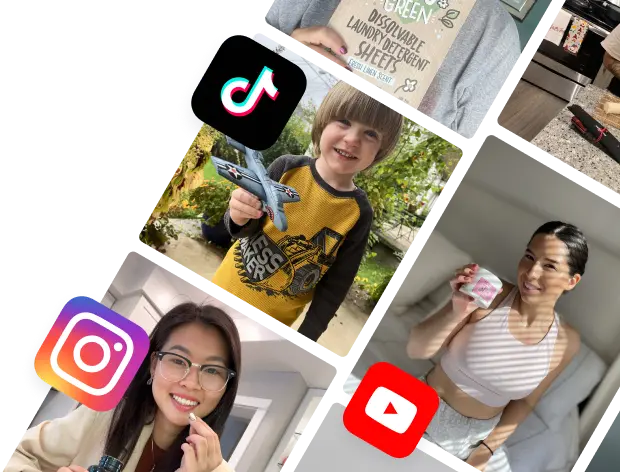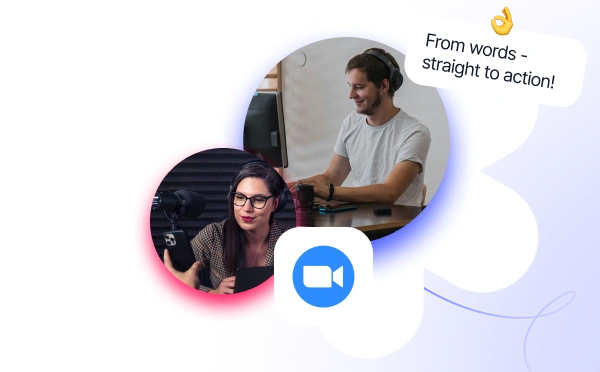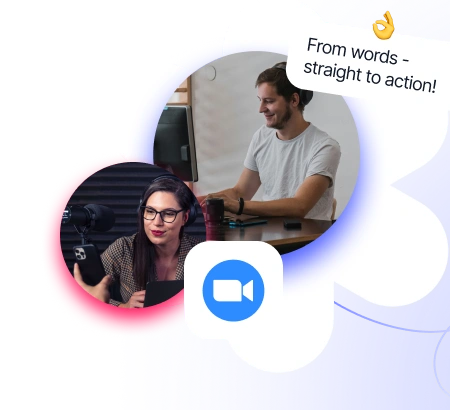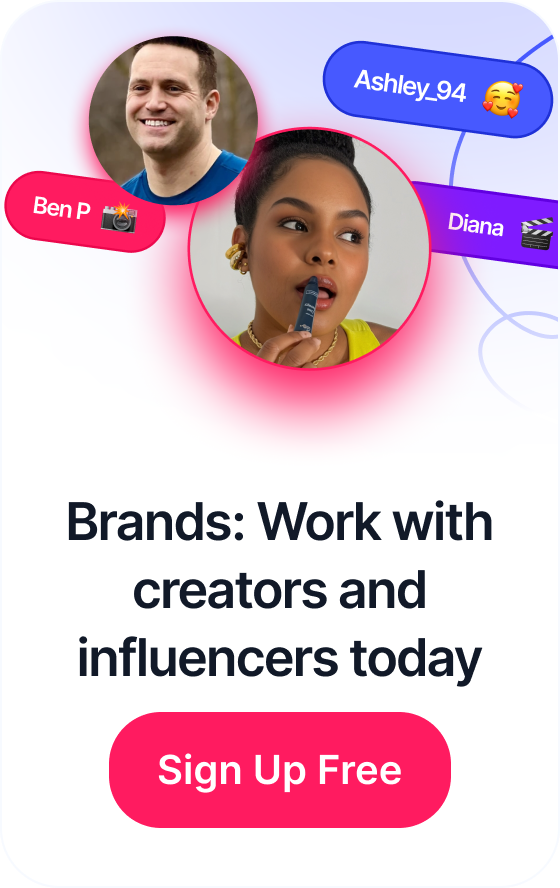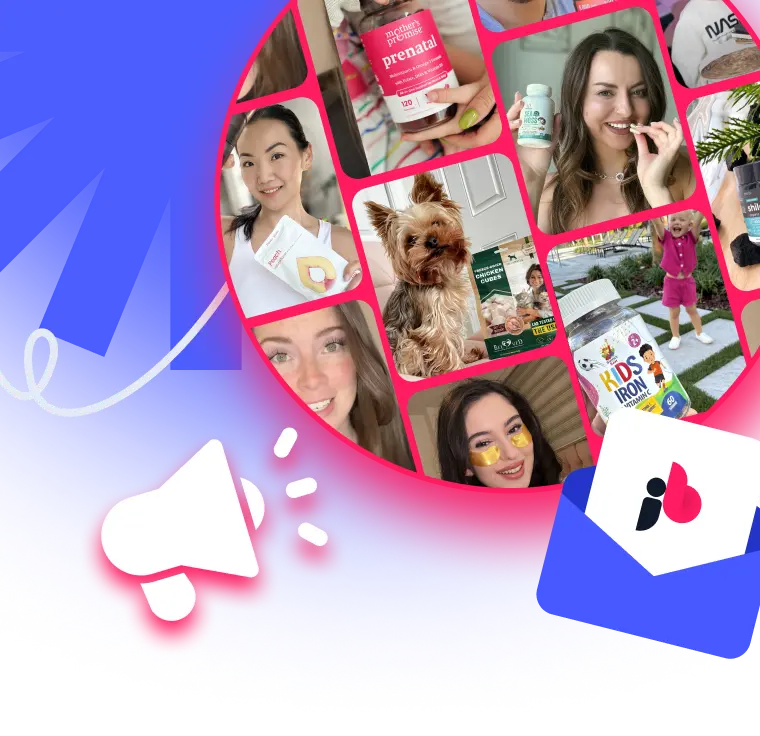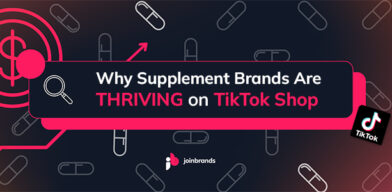 Why Supplement Brands Are Thriving on TikTok Shop
Why Supplement Brands Are Thriving on TikTok Shop
Diving headfirst into the search for content creators without a solid plan is like trying to navigate a new city without a map. You might eventually get somewhere, but you'll waste a lot of time and energy along the way. The real key to success is laying the groundwork first: defining your goals, figuring out your ideal creator persona, and setting crystal-clear campaign objectives.
This initial strategic work is what makes every step that follows focused and effective.
Table of Contents
Building Your Creator Partnership Blueprint
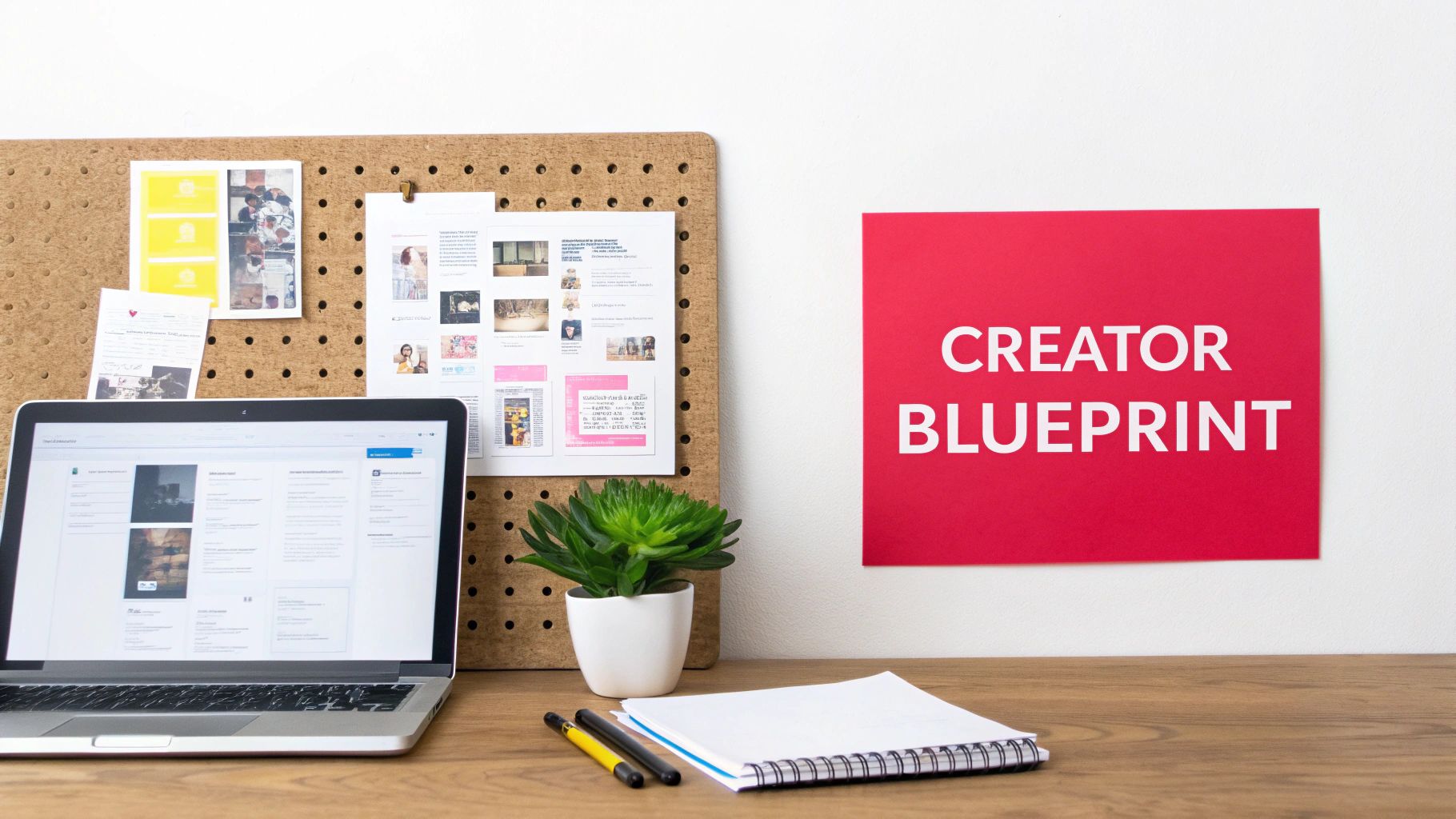
Before you even think about scrolling through feeds, you need a clear vision of what a successful partnership actually looks like for your brand. This blueprint becomes your North Star, guiding your decisions and saving you from endless hours chasing creators who just aren't the right fit.
It's all about moving past vanity metrics like follower counts and focusing on what truly matters: tangible results for your business.
Start by nailing down your primary campaign goal. Are you trying to drive direct e-commerce sales? Or maybe you want to build a library of authentic user-generated content (UGC)? Perhaps the goal is simply to boost brand awareness in a new market. Each of these objectives calls for a totally different type of creator and content style.
Crafting Your Ideal Creator Persona
With your goal locked in, it's time to build out a detailed creator persona. This profile goes way deeper than just basic demographics. You need to think about the specific qualities that will genuinely click with your target audience and feel like a natural extension of your brand's identity.
Here are a few things I always consider when building a persona:
- Brand Voice and Tone: How do they talk to their audience? Is their style funny, educational, or more on the inspirational side? The key is making sure it aligns with your own.
- Aesthetic and Visuals: Take a hard look at their photos, videos, and overall feed design. Does it complement your brand’s look and feel, or does it clash?
- Audience Psychographics: This is huge. Forget just age and location for a second. What are their followers really interested in? What do they value? What are their buying habits?
- Engagement Style: How do they actually interact with their community? You want to see someone fostering real conversations in the comments, not just racking up passive likes.
A well-defined creator persona is the most critical tool in your arsenal. It transforms your search from a broad, overwhelming task into a targeted, strategic mission to find partners who can genuinely connect with your audience and drive results.
Setting the Stage for Collaboration
A solid blueprint also means thinking ahead about your outreach. Proactively finding and connecting with potential partners is a massive part of the process, a lot like mastering outbound lead generation for a sales team.
Once you have your persona dialled in, you can start building a targeted list of prospects who tick all the right boxes. This strategic approach is fundamental to learning how to collaborate with influencers effectively. It ensures that when you finally do reach out, your pitch is relevant, personal, and compelling, setting the foundation for a smooth and successful partnership from the very first message.
Finding Creators Directly on Social Media
Alright, with your creator blueprint in hand, it’s time to roll up our sleeves and go where the creators live. Think of platforms like Instagram, TikTok, and YouTube as massive, searchable talent databases. Your goal is to go beyond a simple search and really dig in to find creators who have built genuine, trusting communities that look a lot like your target audience.
This manual approach is all about quality, not just quantity. It's a crowded space out there—the creator economy has absolutely exploded, with over 165 million new creators jumping onto social media since 2020. And while a platform like YouTube is home to more than 64 million creators, a pretty small fraction actually make it a full-time career. That means you'll be sifting through a lot of profiles to find the right partners. If you want a deeper dive into these numbers, you can learn more about the current creator landscape.
Advanced Search and Discovery Tactics
To find the hidden gems your competitors are missing, you have to get more creative than the main search bar. Instead of plugging in broad terms like "skincare influencer," it's time to get hyper-specific.
Try combining your core topic with niche modifiers. For instance, if you're a brand selling sustainable cookware, you could search for things like:
- "vegan meal prep ideas"
- "low waste kitchen tips"
- "plant-based recipes for beginners"
These long-tail keywords are your ticket to finding micro- and nano-creators with incredibly engaged, specific audiences. Once you find one creator who really fits the bill, use the platform's own features to branch out. On Instagram, check the "Suggested for you" dropdown on their profile. Over on YouTube, explore the "Channels" tab to see who they're recommending. It's a simple but powerful way to find similar creators who are already part of the same community.
Don't just analyze what a creator posts; analyze who they interact with. The 'related accounts' feature is your best friend for discovering entire ecosystems of niche creators who share a similar audience and values.
How to Spot Genuine Influence
Finding a profile is the easy part. Verifying their influence? That's the real work. Genuine engagement is all about the quality of the interactions, not just the raw numbers. When you're looking at a profile, force yourself to look past the follower count and dive straight into the comments section.
Are the comments just generic stuff like "Great post!" or are they thoughtful questions and personal stories? Real communities have real conversations. Take it a step further and check out the profiles of the people commenting. Do they look like actual users who fit your target demographic, or are they a bunch of spam or bot accounts?
A high comment-to-like ratio is almost always a fantastic sign of an active community. It shows the creator's content is actually sparking a dialogue, not just getting a passive double-tap during a mindless scroll. This is where the true value of a partnership lies.
Red Flags to Watch Out For
As you vet potential creators, you've got to keep an eye out for signs of inauthentic activity. Spotting these red flags early can save you from a bad investment and a partnership that goes nowhere.
Common Warning Signs:
- Sudden Spikes in Followers: Use a social analytics tool to look at their follower growth over time. If you see abrupt, unnatural jumps, it's a good sign they've likely purchased followers.
- Low-Quality Comments: A wall of emoji-only comments or generic praise from sketchy-looking accounts is a massive red flag.
- Disproportionate Ratios: A creator with 500,000 followers but only 50 likes per post probably has an inflated audience. Look for engagement rates that make sense for their follower count—a healthy benchmark is typically 1-3% for larger accounts.
Finding the right content creators this way definitely takes time, but this detailed, hands-on vetting process ensures your brand ends up working with authentic voices who can genuinely connect with and influence their audience.
Using Tools to Accelerate Your Search
Let’s be real. Manually scrolling through social media is a great way to get a gut feeling for the creator scene, but it just doesn’t scale. When you need to find not one, but dozens of creators for an ongoing campaign, that manual approach will eat up your entire week. Fast.
This is exactly where dedicated tools and platforms come into play. They can turn your search from a time-consuming grind into a focused, data-driven process.
Think of these tools as more than just a search bar. They are powerful databases packed with vetted creators, giving you access to deep audience analytics, performance history, and even streamlined communication channels, all in one spot.
This infographic gives you a bird's-eye view of the whole process, from that initial discovery to the final vetting, which these platforms are built to simplify.
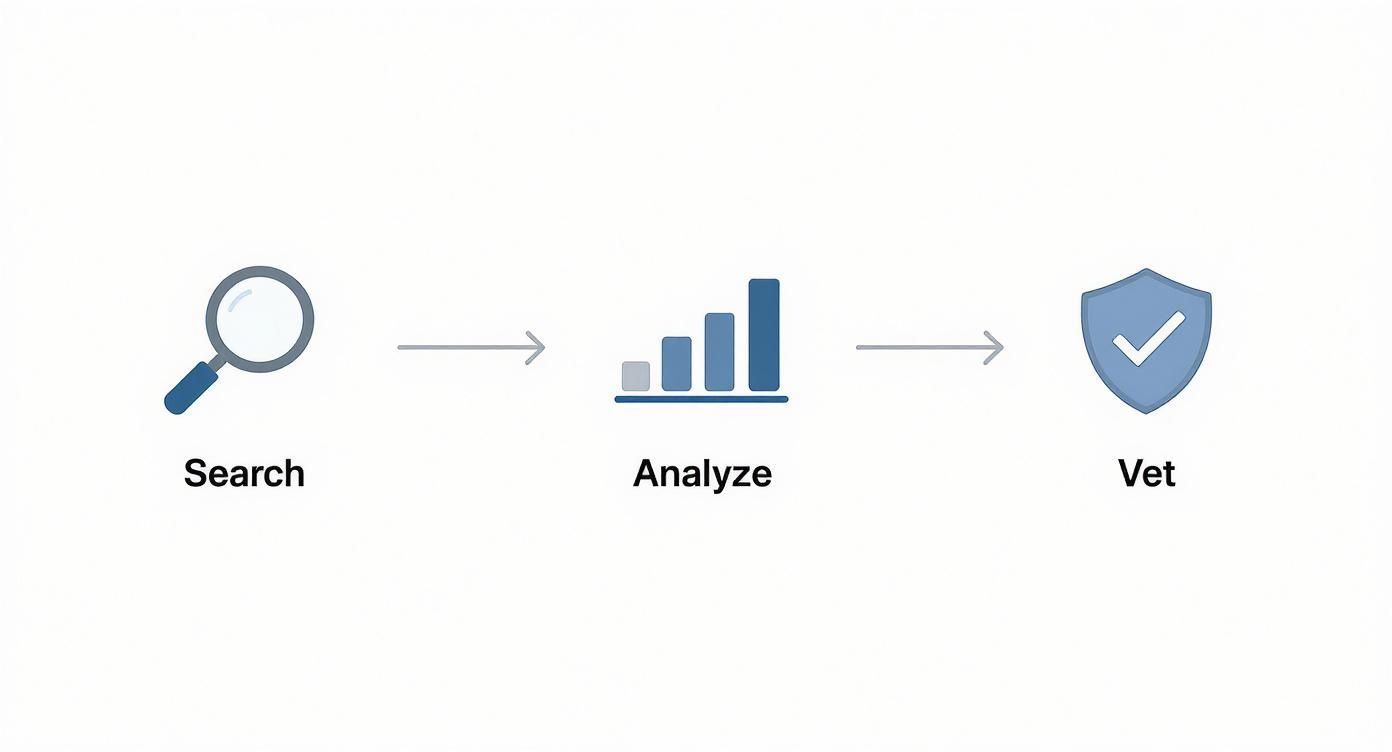
As you can see, the right tech helps you systematically hunt for partners with advanced filters, quickly analyze their data, and confidently check them for things like brand safety and audience alignment.
Choosing the Right Type of Platform
Now, creator discovery tools aren't a one-size-fits-all solution. They typically fall into a few different buckets, each with its own strengths. Knowing the difference is crucial to picking a tool that actually fits your campaign goals and, just as importantly, your budget.
There are a few main types you'll run into:
- Influencer Marketing Suites: These are the all-in-one powerhouses. Think of them as a complete command center for your entire creator program, offering robust discovery, campaign management, and heavy-duty reporting. They're a solid choice for established brands with bigger programs and budgets to match.
- Creator Marketplaces: These operate more like a two-sided marketplace, directly connecting brands with creators who are actively looking for collabs. They're often more affordable and nimble, which makes them perfect for DTC brands that need authentic UGC at scale or startups trying to get a new product off the ground. If this sounds new to you, getting a handle on what a creator marketplace is is a great first step.
- Specialized Discovery Tools: Some tools carve out a specific niche. They might focus solely on finding creators on one platform (like TikTok), or they might specialize in providing ridiculously detailed audience demographic data.
The reality is that no single method is universally "best." It all comes down to your brand's unique needs. Here’s a quick breakdown to help you decide.
Creator Discovery Methods Comparison
| Method | Primary Benefit | Best For |
|---|---|---|
| Manual Social Media Search | Low cost, high authenticity | Niche research, finding emerging talent, small-scale campaigns. |
| Influencer Marketing Suites | All-in-one management | Large brands with ongoing, multi-faceted creator programs. |
| Creator Marketplaces | Speed, scalability, and access to active creators | DTC brands, startups, and campaigns focused on UGC. |
| Specialized Tools | Deep data and platform-specific insights | Brands needing granular audience data or focusing on a single platform. |
This table should make it clear that your strategy will likely dictate your tools. A global B2B company might lean on a full suite, whereas a local DTC brand could get everything it needs from a marketplace.
Putting Tools into Practice
So, how does this look in the real world?
Imagine you’re launching a new line of eco-friendly yoga mats. Instead of endless scrolling, you hop onto a platform and start applying filters. You could instantly narrow your search to creators in the "health and wellness" niche whose audiences are primarily located in your target cities.
From there, you could layer on more filters: an engagement rate above 2%, audience interests in sustainability and yoga, and even specific keywords they've used in past content. A search that would take days by hand can now be done in minutes.
Once you have a solid list of potential partners, the next step is reaching out. If their contact info isn't readily available on the platform, you might need to do a little digging. For those harder-to-find contacts, it's always helpful to have some expert strategies for finding someone's email in your back pocket.
By combining powerful search tools with smart outreach, you're not just finding one creator; you're building a scalable, efficient system for finding the right creators for any campaign you can dream up.
Adapting Your Search for Global and Local Markets
When you're ready to take your brand global, you quickly learn that what worked with creators in your home country can completely miss the mark somewhere else.
Cultural trends, how people communicate, and even which social media apps they use can be wildly different from one region to the next. A universal search strategy just falls flat because it completely ignores these critical local nuances.
The trick is to think globally but act locally. This means you have to dig into specific markets to figure out who actually holds influence and why. A creator who's a household name in the US might have zero recognition in Southeast Asia, where the creator scene is absolutely exploding with its own unique stars and viral trends.
Understanding Regional Creator Ecosystems
Every market has its own distinct creator ecosystem. We're seeing a massive shift in where creators are located. While North America is still the largest market for now, the Asia Pacific region is catching up at an incredible pace.
There are over 207 million active content creators worldwide, but their audience and engagement are anything but evenly spread. To find the right people, you absolutely must get a handle on these local dynamics. You can find more great stats on the state of the creator economy on uscreen.tv.
This data really drives home why your search has to be customized. A campaign aimed at Europe, which makes up 22% of global watch time, will demand totally different creators and content styles than one targeting the Americas, which commands a massive 70%.
Your best creator partnerships will come from understanding that influence is contextual. Instead of asking "Who is a top creator?" ask "Who is a top creator for this specific audience in this specific location?"
Actionable Strategies for Local Discovery
Adapting your search requires a bit of detective work. Before you even think about looking for individuals, figure out which platforms dominate your target region. Sure, Instagram is a global giant, but platforms like LINE in Japan or VK in Russia hold immense local power.
Here are a few practical ways to start finding those local voices:
- Monitor Regional Hashtags and Trends: Keep a close eye on what's trending on the most popular platforms in your target country. This gives you a direct line into what local people are actually talking about.
- Analyze Local Competitors: Check out which creators your local competitors are working with. This can give you a ready-made shortlist of relevant voices who are already proven to work in that market.
- Use Geotargeting on Discovery Platforms: Tools like JoinBrands are built for this. You can filter your search by country, city, and even language, making it so much easier to pinpoint creators who have a genuine, authentic connection with a local audience.
By tailoring your approach like this, you'll start building partnerships that feel authentic and relevant. A successful global strategy isn't built overnight; it's built one strong, local relationship at a time.
How to Vet and Reach Out to Creators

Alright, you've got a solid list of creators who look promising. This is where the real work begins. Getting this next part right is what separates a killer campaign from a costly mistake.
Properly vetting a creator protects your brand, and a thoughtful outreach message is what actually gets them on board. This is where you move from research to building a real relationship.
Don't rush this. Before you even think about hitting "send" on that first DM, you need to do a deep dive. Look beyond their follower count and recent posts. Scrutinize their past brand collaborations. Did the sponsored content feel like a natural fit for their feed, or did it stick out like a cheap ad? You're looking for partners whose sponsored posts get just as much love as their organic ones.
Conducting a Brand Safety Audit
Think of a creator’s past content as their resume. Your job is to conduct a thorough brand safety audit to check for anything that might clash with your company's image or values. This isn't just about dodging major controversies; it's about making sure you're truly aligned.
Get ready to scroll. You need to go back at least six months, but a full year is even better. Keep an eye out for:
- Controversial Takes: Do they have a history of posting polarizing opinions on sensitive subjects that could alienate your customers?
- Inconsistent Tone: Is their content vibe consistent, or does it swing wildly in ways that feel unpredictable and risky?
- Negative Brand Mentions: How do they talk about other brands? Pay attention to both sponsored and unsponsored mentions to get a feel for their professionalism.
Vetting isn't about finding a "perfect" creator—that person doesn't exist. It's about finding a compatible one. The goal is to find a partner whose authentic voice won't give your PR team a headache down the road.
Crafting an Outreach That Gets a Response
Once a creator has passed your vetting process with flying colors, it's time to reach out. The best creators get flooded with pitches every single day, so your generic, copy-paste email is going straight to the trash. Your first message has to prove you've done your homework.
Personalization is everything. Mention a specific video or post of theirs you genuinely enjoyed and explain why it resonated with your brand. This simple step shows you see them as a creative partner, not just another number on a spreadsheet.
Keep your pitch concise and get straight to the point. Respect their time and clearly outline why a partnership would be a win-win. For a deeper dive, check out our complete guide on influencer marketing outreach strategies that actually get replies.
To be taken seriously, your initial pitch needs to nail these key elements:
- A Clear Value Proposition: What's in it for them besides money? Maybe it's early access to new products or exposure to your brand's audience.
- Campaign Overview: Give them a quick snapshot of the campaign. What's the goal? What kind of content are you envisioning?
- Transparent Compensation: Don't be shy about money. Be upfront about your budget by stating your proposed rate or asking for their media kit to get the conversation started professionally.
This approach shows you respect them as a business owner and sets the foundation for a strong, collaborative partnership from day one.
Got Questions About Finding Creators? We've Got Answers
When you're first figuring out how to find content creators, a few questions always seem to pop up. It's easy to get stuck on these hurdles, slowing down your campaign before it even gets off the ground. Let's walk through the most common ones so you can build your strategy with confidence.
"So, How Much Is This Going to Cost?"
This is the big one, right? And the honest answer is: it's all over the map. There's no universal price list for content creation. A nano-creator with 5,000 die-hard fans might be thrilled to create stellar UGC in exchange for a free product. On the flip side, a macro-influencer with 500,000 followers could easily charge thousands for a single post.
It all boils down to a few key factors:
- Audience Size: Generally, more followers means a bigger price tag. No surprise there.
- Engagement Rate: This is a biggie. A creator with a smaller, super-active community can be way more valuable (and cost-effective) than one with a massive but sleepy audience.
- The "Ask": What are you actually asking them to do? A quick Instagram story is worlds apart from a fully-produced YouTube video that requires multiple rounds of edits.
- Exclusivity: If you need a creator to agree not to work with your competitors for a while, you can expect to pay a premium for that peace of mind.
What's the Real Difference Between a "Creator" and an "Influencer"?
You'll hear these terms thrown around interchangeably, but there's a subtle distinction that actually matters for your strategy. It really comes down to their primary value.
An influencer's main asset is their ability to, well, influence. They've built a loyal following that trusts their recommendations, making them powerful partners for swaying purchasing decisions. A content creator, however, is defined by their craft—their exceptional skill in making beautiful photos, sharp videos, or compelling blog posts.
Here's a simple way to think about it: All influencers are content creators, but not all content creators are influencers. You might hire a UGC creator with a tiny following just because their video skills are incredible, with zero expectation that they'll post it for their own audience.
"Seriously, How Long Does It Take to Find the Right Person?"
This is where a lot of brands get tripped up. Finding the perfect creator isn't something you can knock out in an afternoon. If you're doing it the old-fashioned way—scrolling through hashtags, sending DMs, and vetting profiles one by one—you could easily sink weeks into the search.
Using a dedicated creator marketplace can slash that time dramatically, often cutting the process down to a few hours or days.
The most important takeaway here is to budget time for discovery right from the start of your campaign planning. Rushing this step is the fastest path to a partnership that misses the mark, which is a costly mistake in both time and money.
Ready to stop scrolling and start creating? JoinBrands gives you access to over 250,000 vetted creators, ready to collaborate. Our AI-matching and powerful filters help you find your perfect partner in minutes, not weeks. Launch your first campaign for free on JoinBrands today!

